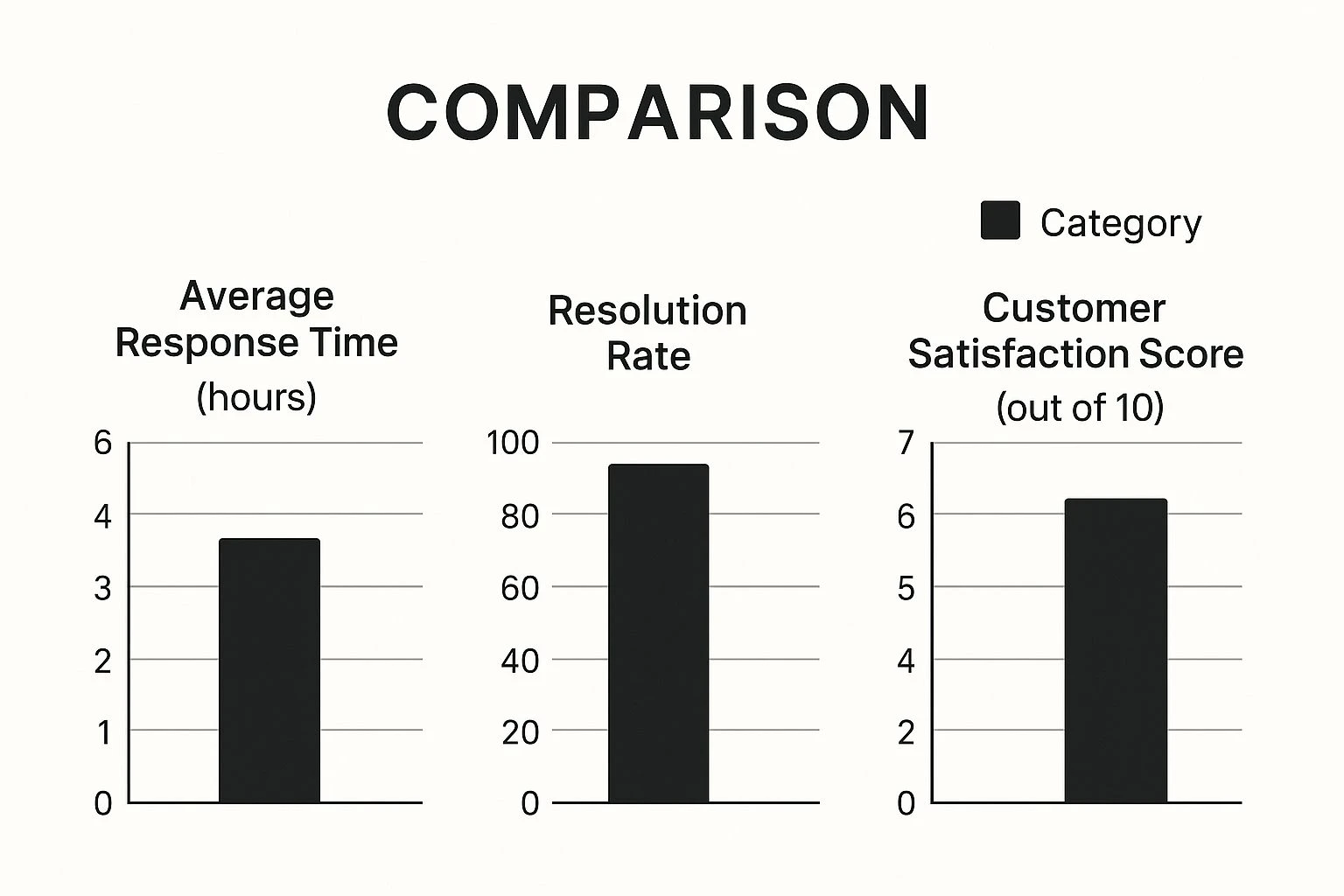How to Explain Customer Service Experience Effectively
May 5, 2025Why Explaining Customer Service Experience Matters Now
Today's consumers are discerning and prioritize experiences over mere products. This makes clearly explaining your customer service experience paramount. Simply offering good service isn't enough; you have to define what "good" entails in concrete, relatable terms. This clarity significantly influences a customer's decision to choose your business, their post-purchase loyalty, and ultimately, your bottom line.
The Impact on Buying Decisions
Imagine two competing online retailers. One vaguely promises "world-class customer service," while the other specifically details its 24/7 live chat support, a 30-day return policy, and phone access to a dedicated team of product experts. Which retailer instills more confidence? The second retailer's specific details provide a clear picture of the support customers can anticipate, positively impacting their purchase decisions. This transparency builds trust before any interaction occurs.
The Role in Customer Loyalty
A well-defined customer service experience also cultivates loyalty. When customers understand what to expect, they are less likely to be disappointed. This predictability strengthens their bond with your brand. Similar to a favorite restaurant, customers return because they know they'll appreciate the food, atmosphere, and service. Consistent, clearly defined service becomes a differentiator that fosters customer retention.
The Business Bottom Line
Conversely, neglecting to explain your service approach can have significant repercussions. This creates expectation gaps, leading to dissatisfaction and lost revenue. In 2025, poor customer service continues to cost businesses billions globally. US companies alone lose $75 billion annually due to inadequate support systems and inefficient problem resolution. This substantial figure emphasizes the need to invest in and clearly explain a robust customer service experience. Zendesk reports that 73% of consumers switch to competitors after multiple negative experiences, revealing a global intolerance for subpar service. The $4.7 trillion annual loss in global consumer spending attributed to negative experiences further underscores the financial importance of prioritizing CX improvements. Learn more about customer service statistics here: https://www.zendesk.com/blog/customer-service-statistics/
Avoiding the Expectation Gap
Your customer service experience needs to be more than just a department; it needs to be a story. It's the narrative connecting your brand promise to the reality of customer interactions. By effectively communicating your service model, you empower customers with the information they need to make informed choices, fostering positive, lasting relationships.
The Anatomy of Exceptional Service Explanations

Explaining your customer service experience is more than just making promises. It's about crafting a compelling story that resonates with both your customers and your team. This involves carefully connecting each customer touchpoint with the emotions it creates. This takes abstract ideas like "great service" and turns them into concrete experiences customers can readily understand.
Defining Measurable and Intangible Aspects
A strong service explanation includes both measurable factors and the less tangible elements that truly shape customer perception. Measurable elements include concrete metrics like response times and resolution rates. These offer quantifiable data demonstrating efficiency.
However, the intangible aspects – empathy, personalization, and genuine human connection – are what customers truly value and remember.
To illustrate this point, consider a customer struggling with a technical issue. While a quick resolution is always appreciated, an agent who demonstrates understanding and patiently guides them through the troubleshooting steps will leave a much stronger positive impression. This highlights the crucial role of the human element in customer service. You might be interested in: How to master customer service quality assurance.
The Power of Language
The language used to describe your service has a significant impact on customer expectations. Even small changes in wording can dramatically alter how customers perceive your service. For example, saying "We aim to respond within 24 hours" creates a different expectation than "We respond to all inquiries as quickly as possible."
While the latter sounds positive, it lacks the concrete reassurance of the former. This underscores the importance of using precise, actionable language in crafting a clear and trustworthy service narrative. Maintaining consistent language across all communication channels reinforces this clarity and strengthens your brand identity.
To help illustrate the key components of a positive customer service experience, let's look at the table below:
Customer Service Experience Component Framework This table outlines the key components needed to fully explain customer service experience and how each contributes to the overall customer perception.
| Component | Definition | Business Impact | Customer Perception |
|---|---|---|---|
| Response Time | How quickly a customer receives a response to their inquiry. | Impacts efficiency and customer satisfaction. | Demonstrates responsiveness and care. |
| Resolution Rate | Percentage of inquiries resolved satisfactorily. | Shows effectiveness of support processes. | Builds confidence in problem-solving abilities. |
| Empathy | Understanding and acknowledging customer feelings. | Improves customer relationships. | Creates a sense of being valued and heard. |
| Personalization | Tailoring the service interaction to individual customer needs. | Increases customer loyalty. | Shows attentiveness and strengthens connection. |
| Clear Communication | Using precise and consistent language. | Manages expectations effectively. | Builds trust and transparency. |
This table highlights how tangible metrics and intangible qualities work together to shape a positive customer experience. By focusing on each of these components, businesses can create a service experience that resonates with customers and drives loyalty.
Transforming Service Explanations: Real-World Examples
Many organizations have achieved measurable improvements by refining how they explain their service approach. One company transformed its generic "excellent customer service" promise into a detailed description of its multi-channel support system, including 24/7 chat, email support with a guaranteed 12-hour response time, and personalized onboarding sessions for new customers.
This change led to a 15% increase in customer satisfaction and a 10% reduction in support ticket volume, proving the tangible benefits of clear communication. Another example involves a software company that implemented AI-powered chatbots to handle basic inquiries, allowing human agents to focus on more complex issues.
By clearly explaining this blended support approach to customers, the company effectively managed expectations while simultaneously improving both efficiency and customer satisfaction. This shows the power of combining technology with a well-defined service narrative. These real-world examples underscore the importance of aligning your service explanation with your actual service delivery to foster trust and consistently surpass customer expectations.
Technology That Transforms Service Narratives

Crafting a compelling narrative around your customer service experience depends heavily on using the right technology. Successful companies use tools that not only bring clarity and standardization to their service approach but also allow them to personalize interactions at scale. Finding the right balance between consistent service and individualized attention is crucial for building a positive brand image.
AI-Powered Platforms: Balancing Automation and Human Connection
Artificial intelligence is changing the face of customer service. AI-powered platforms offer a range of solutions, including chatbots for instant support, predictive analytics to anticipate customer needs, and sentiment analysis to gauge customer emotions. These tools can significantly improve the efficiency and consistency of your service delivery.
However, the human touch remains essential. While AI can handle routine questions, complex issues often demand the empathy and nuanced understanding that only human agents can provide. This highlights the importance of integrating AI in a way that supports, rather than replaces, human interaction. Learn more about how to strike this balance: How to master customer support automation.
Bridging the Gap Between Promises and Delivery
Selecting the appropriate technology is paramount. Some solutions can inadvertently create unrealistic expectations that your business may not be able to meet, leading to increased customer frustration. For example, promising immediate support via chatbots without sufficient human backup for complex issues can erode customer trust.
Businesses should carefully evaluate technology based on its ability to truly improve the customer experience, not simply automate processes. Focusing on genuine enhancement builds long-term customer loyalty and strengthens your brand.
Practical Approaches for Technology Selection
A practical approach to technology selection focuses on solutions that directly address pain points in the customer journey. This might involve implementing an email ticketing system like Aidlify to streamline support inquiries or integrating a knowledge base to empower customers with self-service options.
Furthermore, businesses should prioritize technologies that facilitate data integration. A unified view of the customer enables personalized service at every touchpoint, creating a more seamless and satisfying experience.
As of 2025, only 25% of call centers have successfully integrated AI automation, leaving a 75% gap in operational efficiency. This slow adoption is surprising, considering that 65% of customers expect faster responses than they did five years ago, and 86% of agents report higher customer expectations. More statistics can be found here: https://www.amplifai.com/blog/customer-service-statistics. This disparity underscores the need for a balanced approach: leveraging AI's power while prioritizing the human element of customer service. Striking this balance is the key to transforming service narratives and creating exceptional customer experiences.
Crafting Service Stories That Actually Resonate

Forget generic promises. Truly connecting with customers hinges on mastering the art of service storytelling. This means building compelling narratives around the customer experience that not only clarify expectations but also set your brand apart. Forward-thinking organizations recognize the value of transforming abstract service concepts into memorable and engaging stories.
Transforming Abstract Concepts Into Tangible Experiences
Imagine your customer service experience as a journey. Each interaction, from the first website visit to post-sale support, forms a chapter in that story. Instead of simply listing features, paint a picture of how your service empowers customers to reach their goals.
For example, rather than stating "fast response times," illustrate the experience. Describe how a customer can expect a reply from a knowledgeable agent within the hour, ready to provide assistance. This creates a much clearer and more engaging image for the customer.
Adapting Service Explanations Across Channels
Much like a story adapts to different mediums, your service explanation should resonate across various channels. The core message remains consistent, but the delivery is adjusted. A concise, benefit-driven summary works well on social media platforms like Twitter. A more detailed narrative might be better suited for your website's FAQ section. This ensures a clear and consistent customer service message, no matter how customers interact with your brand. Tools like voice analytics can be particularly helpful in understanding and refining these customer interactions.
Language, Metaphors, and Visualization
Specific language choices can instantly clarify your service philosophy. Metaphors can simplify complex ideas. For instance, calling your support team "customer advocates" immediately communicates a sense of dedication and care.
Visualizations, such as flowcharts that illustrate the support process, further enhance understanding. By combining these techniques, you can craft a service narrative that's both memorable and impactful.
From Promises to Powerful Narratives
Let's compare two scenarios. Company A promises "exceptional customer service." Company B paints a picture: "Imagine needing help with our new software. You reach out via chat, and within minutes, a friendly expert guides you to a solution, getting you up and running smoothly."
The second scenario provides a tangible, relatable experience. It resonates far more effectively than a simple, generic promise. By weaving compelling narratives, you're not just explaining customer service—you're building anticipation for a positive experience.
Measuring What Matters in Service Experience

Tracking numerous metrics can feel like progress, but it's essential to ensure these measurements translate into real improvements in service delivery. This means focusing on Key Performance Indicators (KPIs) that offer actionable insights. By understanding the right KPIs, you can truly grasp and elevate the customer experience.
Choosing the Right KPIs
A strong connection exists between the quality of customer experience (CX) and revenue growth. Data from the Temkin Group shows that companies with $1 billion in annual revenue gain an average of $700 million within three years by focusing on great CX. This demonstrates a substantial return on investment. More statistics are available at SuperOffice.
However, despite 54% of support teams lacking the tools for personalized experiences at scale, 3 out of 4 consumers spend more with businesses offering these tailored experiences. This gap highlights the need for investment in the right tools and strategies.
The rise of omnichannel support, with 79% of agents now handling a wider range of products, demands seamless integration across various communication platforms. For a deeper dive into this topic, check out this article on customer service performance indicators. Selecting the right KPIs to reflect these changes is key for continuous growth.
From Data to Narrative: Demonstrating ROI
Collecting data is just the first step. You must also be able to transform the data into a compelling narrative that demonstrates the return on investment (ROI) of service improvements. This means turning numbers into stories.
For instance, showing how reducing average handling time, combined with higher customer satisfaction, directly boosts customer retention can justify further investment in customer service. This approach creates a data-driven narrative that clearly links service performance with tangible business outcomes.
Visualizing Data: The Power of Charts
To better understand the relationship between key metrics and business growth, let's look at the data chart below. This data chart visualizes a hypothetical company's performance, showing how different customer service metrics relate to overall business growth.
| Metric | Q1 2025 | Q2 2025 | Q3 2025 | Q4 2025 |
|---|---|---|---|---|
| Customer Satisfaction (CSAT) | 75% | 82% | 88% | 92% |
| Net Promoter Score (NPS) | 45 | 55 | 62 | 70 |
| Customer Retention Rate | 60% | 68% | 75% | 80% |
| Revenue Growth | 2% | 5% | 8% | 10% |
This bar chart reveals a strong correlation between improving customer service metrics and driving revenue growth. As CSAT, NPS, and customer retention rise, revenue follows suit. This visual representation underscores the importance of investing in the customer experience.
To further explore how different metrics impact customer service, let's look at the following comparison table.
Customer Service Experience Metrics Comparison: A comparison of different metrics used to measure and explain customer service experience effectiveness
| Metric | What It Measures | Strengths | Limitations | Best Used For |
|---|---|---|---|---|
| Customer Satisfaction (CSAT) | Customer happiness with a specific interaction | Easy to understand and collect | Can be influenced by external factors | Measuring short-term satisfaction |
| Net Promoter Score (NPS) | Customer loyalty and likelihood to recommend | Provides a broad measure of customer sentiment | Doesn't reveal specific areas for improvement | Tracking overall loyalty |
| Customer Retention Rate | Percentage of customers who continue doing business with a company | Directly reflects business impact | Can be a lagging indicator | Measuring long-term success |
| Customer Effort Score (CES) | How easy it is for customers to interact with a company | Identifies pain points in the customer journey | Doesn't measure overall satisfaction | Improving customer processes |
This table highlights the strengths and weaknesses of different metrics, allowing businesses to choose the most relevant KPIs for their specific needs. Focusing on a combination of these metrics can provide a more holistic view of the customer experience.
Empowering Teams to Deliver on Service Promises
Even the most well-crafted customer service explanations won't succeed without a skilled team to put them into action. Turning service philosophies into consistent daily practice is the mark of a successful organization. This means giving your team the right tools and knowledge to truly embody your service standards. For further insights, check out this helpful resource: How to master help desk best practices.
Training for Internalization
Effective training is key to empowering your team to understand and deliver on your service promises. This goes beyond memorizing scripts. It's about helping your staff internalize the core values behind your service approach. This deeper understanding empowers them to explain your service philosophy to customers naturally and with confidence. Role-playing scenarios and interactive workshops, for example, can be valuable tools. These methods simulate real-world customer interactions and build essential problem-solving skills.
Handling Service Exceptions
No service experience is flawless. There will inevitably be times when things don't go according to plan. Preparing your team for these service exceptions is crucial. This means providing clear guidelines and empowering them to make informed decisions. These decisions should always align with your overall service narrative. This flexibility allows your team to adapt to unexpected situations while still maintaining a positive customer experience.
Empowering Employees for Decision-Making
Giving employees the power to make on-the-spot decisions is essential for excellent service. This means granting them the autonomy to resolve customer issues without constant oversight. This trust leads to faster resolutions and a more personalized experience for the customer. It also creates a sense of ownership and responsibility within the team, boosting morale and improving overall service quality.
Continuous Feedback and Refinement
Creating a continuous feedback loop is key to improving both service delivery and explanation. Regularly gathering feedback from both customers and employees allows you to identify areas for improvement. You can then adjust your strategies as needed. This iterative approach is essential for maintaining a positive customer service experience. By analyzing customer interactions and identifying recurring issues, you can proactively refine your service approach and address potential problems.
This ongoing refinement ensures your service story evolves while staying true to its core values. It also fosters a culture of learning and improvement within the team, driving continued excellence in service delivery.